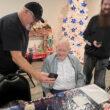Sean C. Morgan
Ending the third year of the Commercial Exterior Improvement Program, the Sweet Home Active Revitalization Effort and local building owners have spent $168,462.41 on improvements.
Not counting the impact of the Keesecker Building in 2010, the annual return on SHARE grants in 2012 was the biggest it has ever been.
In 2010 the program generated about $91,500 on 14 projects. SHARE contributed about $15,000.
In 2011, the program generated about $47,000 on 13 projects, while SHARE paid $18,300.
This year, SHARE spent $8,300 on nine projects, while total projects were worth about $29,700, more than three times the amount SHARE spent.
The grants are made by SHARE from Oregon Jamboree proceeds provided by the Sweet Home Economic Development Group, under whose umbrella SHARE operates.
During the first two years of the program, SHARE provided flat grants, with no spending requirement for property owners.
This year, SHARE started granting money with a required contribution from the building owner or occupant. Grants paid a percentage of the total project up to a limit: 75 percent for painting, 50 percent for signs and 25 percent for landscaping. The maximum possible grant was increased to $1,500 for Chamber of Commerce members and $750 for non-members. The old maximum grant was $1,000, and most of the time, the building owner contributed.
“We could help them on a larger level,” said Economic Development Director Brian Hoffman.
CEIP has had fewer projects, but they’ve had a greater total value, he said.
“This year, we also added the design assistance, paid for through the program,” Hoffman said. SHARE has created a photo library from a trip to several other Oregon cities. The images show buildings that “work” and buildings that “didn’t work.”
The photo library works as a reference for ideas as business owners think about their projects, he said.
The program is aimed at improving the curb appeal of downtown businesses, and the grants are available to businesses in commercial zones. Projects include street-facing improvements, painting, awnings and signs. Interior projects do not qualify.
Project proposals must be approved by the SHARE Planning Committee. SHARE reimburses the expenses after the project is complete.
Among the 2012 projects, CEIP completed one larger project at a priority site, Speedee Mart.
Projects such as Speedee Mart, called demonstration projects, are more strategic projects with a higher impact, Hoffman said. SHARE contacts them proactively.
SHARE provided a grant above and beyond the usual limits of the CEIP program. The building was identified at the beginning of the year as one of SHARE’s top 10 priorities.
Priorities are ranked based on the need for improvements, location and marketability, encouraging additional investment by surrounding businesses and potential for private funding, Hoffman said. “It’s a way to put the program out there. We’re able to help at a higher level.”
“I think the results are starting to show,” he said. “What we have now is basically what you’re going to see. We’re happy with the results. We’d like to see more investment.”
Other businesses have painted and made improvements in the past year too without CEIP’s involvement, businesses such as the Swan restaurant and the Money Man, he said.
CEIP is planning to send postcards to those business to thank them for their contributions to improving Sweet Home’s appearance, Hoffman said.
“As we improve and strengthen the image, it becomes more desirable for new businesses to start in Sweet Home,” he said.




